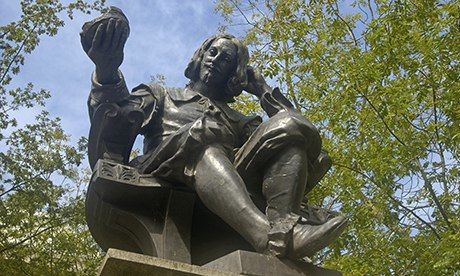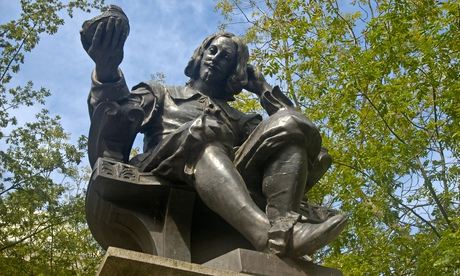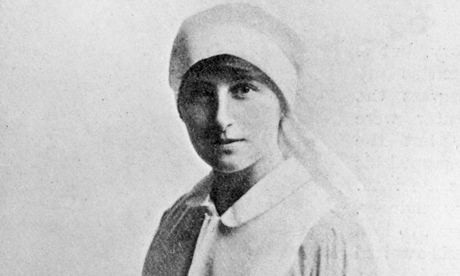Consider the following inventory of questions and conjectures. What did John the Baptist wear? Were there rainbows before the Flood? Is it unlucky to sneeze between midnight and noon? How to account for the "strange and mystical transmigrations of silkworms"? Or the bizarre hirsutism that afflicts Provençal children? Did Jesus laugh? Did he lie down to eat? What are the diseases associated with the climate of Iceland? The likely outcome if you imprison a mole, a toad and a viper together, under glass? (As it happens, the mole prevails.) Now imagine a writer of such rigour, daring and erudition, so prodigiously equipped in style and powers of observation, a scholar so curious he could pass comfortably from such problems to reflections on magnetism, coral, crystallography, ballistics, porcelain and the human eyelid. Such and more was Sir Thomas Browne: a 17th-century physician whose voracious essayism trumped all in a period hardly lacking for literary and scientific experiment.
He was born in Cheapside in 1605, the year Francis Bacon published The Advancement of Learning. It is customary to say that Browne's life passed without incident outside the learned purviews of his medical practice and literary output. Reid Barbour's detailed biography goes a long way towards proving that it was in fact "a remarkable life", lived with "uncommon intensity". Its public drama, though, was mostly a matter of context and connections – Browne's knowledge, thought and influence expanded as his private sphere contracted. After medical studies at Oxford, Montpellier, Padua and Leiden, he settled in Norwich in 1637, and by all local accounts was an assiduous and kind attendant at the sickbeds of the Norfolk gentry. But by the time of his death, on his 77th birthday, Browne was also a writer of international repute, a friend and correspondent to the likes of John Evelyn and the virtuosos of the new Royal Society. And in the one area of his influence that Barbour unaccountably scants, he had contrived the oddest, most alluring prose of his century – perhaps of all English essayists.
Browne's first book was Religio Medici: a young physician's statement of complex Christian faith and allegiance, written at a time when doctors were routinely accused not only of lust, corruption, greed and ignorance, but also outright atheism. Barbour reconstructs the potentially lethal political and theological perplex into which – reluctantly, so he claimed – Browne launched his book. Norwich was a Puritan stronghold, and the Religio risked making its author seem an apologist for popery. But such was his ambiguous accommodation between competing orthodoxies that in the years Browne spent revising his reflections they were claimed by the Quakers, censured by the Vatican and gave rise to a new popular genre in which adepts of various professions described their religious beliefs, whether in consort with, or pious opposition to, the writings of Dr Browne.
Browne wrote and thought in a period that hovers fascinatingly between the old conventions of Galenic and Aristotelian authority and the new protocols of experiment and autopsia (direct and personal observation). It's this suspension that makes his second major work, a catalogue of learned errors, seem so rich and strange. As Barbour tells us, Browne conducted his own experiments: he weighed the brains of sparrows and recorded the habits of his pet eagle and bittern. But he was half in love too with the bestiary of antique and wrongheaded lore. Pseudodoxia Epidemica, published in 1641, is a cabinet of pseudoscientific curiosities: from the plausibility of griffins and unicorns, through the basilisk's famed ability to kill at a distance, to the common belief that a badger's legs are shorter on one side. Browne could be sensibly unprejudiced – he rejected the myth that Jews smell – but there were limits to his modernity. Barbour recounts his mysterious role as expert witness in a witch trial at Bury St Edmunds in 1662: he spoke of "the Mother" (that is, hysteria), but did not deny the existence of witchcraft, and the two accused women were hanged.
Barbour has marshalled an impressive amount of newly revealed documentation regarding such incidents in the life, and a deal of supporting evidence about the civic and intellectual contexts in which his subject worked. What he does not give us, sadly, is much of a sense of Browne the writer. It's not that he's unaware of or indifferent to the wonders and innovations of the prose, but when he does turn to the specifics of Browne's extraordinary style, he seems to be working at some hampering remove from its texture, preferring to focus on simple word choice. For sure, Browne's vocabulary is well stocked and surprising – among more recondite inventions, he gave us "suicide", "cylindrical", "computer" and "electricity" – but it is not quite adequate to say of his sentences, which proceed by strategies of stately accretion and sly parallelism, punctuated by instances of sublime aphorism, that they are merely "sonorous" or "fragmentary". Or worse: to note blithely that Browne's prose constituted "a brand of its own".
Faced with a biography of such historical and intellectual ambition, so carefully grounded in contemporary accounts of medical and theological controversy, it is probably churlish to wish that Barbour had spent more time retelling the adventure of Browne's writerly development than he does, for example, on the tax laws regarding woollen garments in the 17th century. But the truth is that no amount of archival ferreting will exactly account for sentences such as one discovers in Hydriotaphia, Browne's account of Saxon burial urns – he thought they were Roman – unearthed in Norfolk. For sheer prose metrics Browne is peerless: "Time which antiquates Antiquities, and hath an art to make dust of all things, hath yet spared these minor Monuments." His is not the morbidly metaphoric brilliance of John Donne's sermons, or the "rhapsody of rags" you find in Robert Burton's swelling Anatomy of Melancholy – but he frequently outdoes both in his pure pleasure at turning fact and surmise into resplendent periods.
Browne's literary afterlife has been varied: a century and a half ago he was adduced as the very model of high style; later obscured, he now looks central to the early modern age of curiosity. The novelist William H Gass once wrote that "producers of prose do not play scales or improve their skills by repeating passages of De Quincey or Sir Thomas Browne, although that might be a good idea." The style has not been for everyone. Samuel Johnson complained that "his tropes are harsh, his combinations uncouth"; but Johnson had borrowed enough from Browne to feel bitter. The Victorians certainly overvalued the music of his prose at the expense of his ideas and the culture that nourished them. Others – among them Coleridge, Lamb, Carlyle, Poe, Melville and Woolf (who loved his "immense egotism") – mined Browne for rhythms and effects that resurfaced most recently in WG Sebald's melancholic treatment of him in The Rings of Saturn. Barbour's Life sets all of this wavering reputation in meticulous context.









